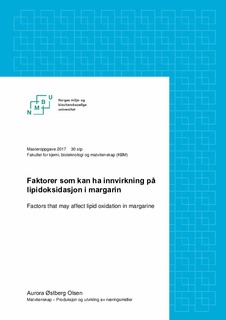| dc.contributor.advisor | Varela, Paula | |
| dc.contributor.advisor | Egelandsdal, Bjørg | |
| dc.contributor.advisor | Christiansen, Kirsti Forstrøm | |
| dc.contributor.author | Olsen, Aurora Østberg | |
| dc.date.accessioned | 2017-09-06T11:34:08Z | |
| dc.date.available | 2017-09-06T11:34:08Z | |
| dc.date.issued | 2017 | |
| dc.identifier.uri | http://hdl.handle.net/11250/2453379 | |
| dc.description.abstract | Margarin og andre matvarer med et høyt innhold av flerumettede fettsyrer er utsatt for lipidoksidasjon og vil gi harsk smak, som anses å være en alvorlig kvalitetsfeil, både sensorisk og ernæringsmessig. Holdbarheten til margarin begrenses av lipidoksidasjon, i motsetning til en del matvarer hvor mikrobiologisk vekst er den begrensende faktoren. Lipidoksidasjon i emulsjonssystemer er kompleks og reaksjonsmekanismene for lipidoksidasjon er fremdeles ikke helt forstått, på tross av omfattende forskning siden begynnelsen av det 20. århundre.
Denne masteroppgaven studerte den oksidative stabiliteten hos ni margariner ved hjelp av kjemiske og sensoriske analyser, og var et samarbeid med Mills DA. Fokuset var rettet mot mulige faktorer som kan ha innvirkning på lipidoksidasjon i margarin, som melk, salt, prosessbetingelser eller vanndråpestørrelse. Forsøksdesignet var basert på tre av Mills DA sine kommersielle margariner, hvor innhold av melk, salt og lecitin er ulikt. Disse tre margarinene ble fremstilt i pilotskala, i tillegg til tre varianter hvor melk enten ble erstattet med vann eller vann ble erstattet med melk. Prøvene ble lagret ved ulike temperaturer, og analysene ble utført ved ulike stadier i holdbarhetsløpet. Et trent sensorisk panel vurderte de seks pilotprøvene, og dette ble sammenlignet med andre analyser som måler oksidasjon; peroksid-, anisidin-, TBA-verdi, GC-MS og fluorescens spektroskopi.
Resultatene viste at en av margarinprøvene skilte seg klart ut fra de andre med langt høyere verdier for harsk smak og andre oksidasjonsverdier målt ved flere av de andre analysene. Den prøven inneholdt verken melk eller lecitin, men natriumklorid. Det ble produsert en lignende margarin hvor melk ble tilsatt, denne viste signifikant lavere verdier på oksidasjonsanalysene. En annen margarin inneholdt heller ikke melk, men salt og lecitin, denne var også signifikant mindre harsk. Margarinprøvene som inneholdt lecitin og/eller melk var langt mindre oksidert enn prøven som inneholdt hverken av de to råvarene. Basert på denne oppgaven ser det derfor ut til at lecitin og/eller melk(eproteiner) har positiv innvirkning på margariners oksidative stabilitet, enten fordi de fungerer som synergist og fremmer annen antioksidativ aktivitet eller påvirker grenseflateområdet i en positiv retning. | nb_NO |
| dc.description.abstract | Margarines and other foods with a high content of polyunsaturated fatty acids are prone to lipid oxidation, which is considered a serious quality defect from a sensory and nutritional point of view. An oxidatively stabile margarine is considerably more economical in terms of shelf life, and will consequently taste better. Despite extensive research since the beginning of the 20th century, lipid oxidation in emulsion systems is complex and the reaction mechanisms for lipid oxidation are still not fully understood.
This master thesis studied the oxidative stability of nine margarines using chemical and sensory analyzes, and was a collaboration with Mills DA. The focus was directed to explore the factors that may affect lipid oxidation in margarine, such as milk, salt, process conditions or water droplet size. The experimental design was based on three of Mills DA's commercial margarines, where the content of milk, salt and lecithin content were different. These three margarines were made in pilot scale, in addition to three variants where milk was either replaced with water or water was replaced with milk. The samples were stored at different temperatures, and the analyzes were performed at different stages of the shelf life. A trained sensory panel assessed the six pilot samples, and this was compared with other analyses that measure oxidation; Peroxide value, anisidine value, TBA value, GC-MS and fluorescence spectroscopy.
The results showed that one of the margarine samples was significantly different from the others with far higher values for rancid taste and other oxidation values as measured by several of the other analyses. That sample did not contain milk or lecithin, but did contain sodium chloride. A similar margarine was produced, where milk was added, and this showed significantly lower values of oxidation. Another margarine did not contain milk, but salt and lecithin, and this was also significantly less rancid. The margarine samples containing lecithin and/or milk were far less oxidized than the sample containing neither of the two raw materials. Based on this thesis, lecithin and/or milk(proteins) therefore appear to have a positive impact on the oxidative stability in margarine, either because they act as synergist and promote other antioxidative activity or because they affect the interface area in a positive way. | nb_NO |
| dc.description.sponsorship | Mills DA | nb_NO |
| dc.language.iso | nob | nb_NO |
| dc.publisher | Norwegian University of Life Sciences, Ås | nb_NO |
| dc.rights | Attribution-NonCommercial-NoDerivatives 4.0 Internasjonal | * |
| dc.rights.uri | http://creativecommons.org/licenses/by-nc-nd/4.0/deed.no | * |
| dc.subject | Lipidoksidasjon | nb_NO |
| dc.subject | Margarin | nb_NO |
| dc.subject | Oksidasjon | nb_NO |
| dc.title | Faktorer som kan ha innvirkning på lipidoksidasjon i margarin | nb_NO |
| dc.title.alternative | Factors thay may affect lipid oxidation in margarine | nb_NO |
| dc.type | Master thesis | nb_NO |
| dc.source.pagenumber | 140 | nb_NO |
| dc.description.localcode | M-MAT | nb_NO |

